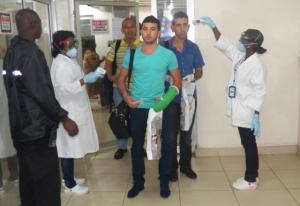Liberia: promoting safe air travel
“Excuse me, Sir, I need to take your temperature.”
These words are often overheard these days at the international airport of Monrovia, where a group of doctors and nurses from the Ministry of Health of Liberia screen passengers arriving and leaving the country for Ebola.
When people leave Liberia, they also complete a form to evaluate whether they are at risk of infection because they have had contact with someone sick with Ebola. If someone presents with fever or symptoms compatible with Ebola, another questionnaire is completed to assess if that person might be sick with Ebola. “We have detected several people with fever,” says Dr Lindgren Sokan, who works at the Roberts International Airport.
Bendu Yekeh is one of the nurses who do the screening. “People are cooperating with the health unit. And they are very aware of the disease,” she said.
Risk of transmission of Ebola is low during air travel
The risk of transmission of Ebola virus disease during air travel is low. Unlike infections such as influenza or tuberculosis, Ebola is not transmitted through the air. Transmission requires direct contact with the body fluids of infected living or dead persons or animals.
Liberia is acting in accordance with International Health Regulations recommendations issued in August 2014, which say that states with Ebola transmission should conduct exit screening for unexplained fever of all passengers departing from international airports, seaports or travelling through major land crossings. Any passenger who has an illness with symptoms suggestive of Ebola should not be allowed to travel unless the travel is part of an appropriate medical evacuation.
Guinea and Sierra Leone, the other 2 countries most heavily affected by the current outbreak in west Africa, have also adopted screening measures. The United States Centers for Disease Control and Prevention, which is working closely with WHO on the outbreak, is assisting all 3 countries with screening procedures and training staff.



